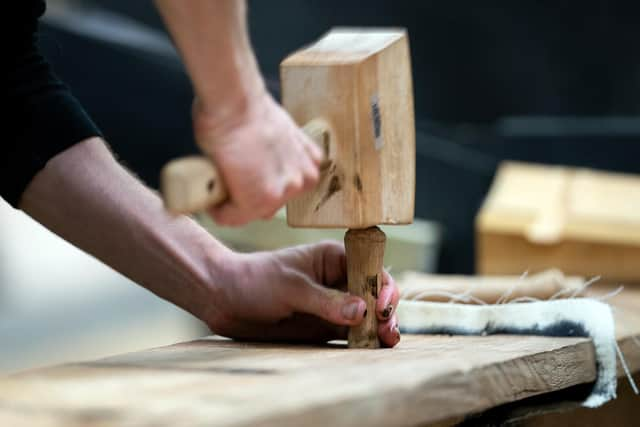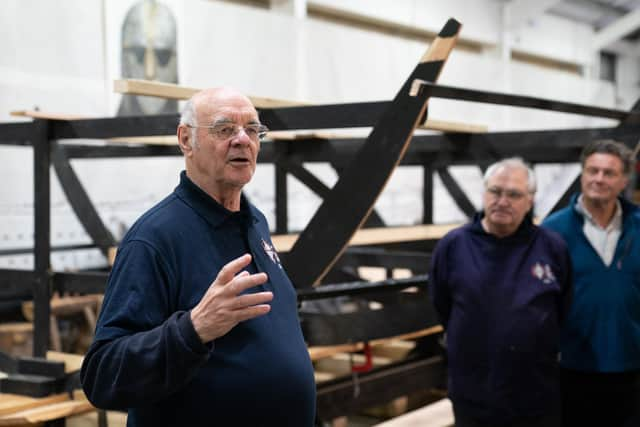Meet the Sutton Hoo archaeologist building replica 'ghost' ship to sail through centre of York
Now the famous Sutton Hoo 'ghost' ship, once the final burial place of a seventh-century warrior king, sees its royal story brought to life once more.
Prof Martin Carver, an emeritus professor at the University of York, is leading a project to reconstruct this famous build, based on imprints from old archaeological digs.
Advertisement
Hide AdAdvertisement
Hide AdThe ambition is to see a replica of this great ship rowed upriver including on Yorkshire's Humber and Ouse, retracing its lost voyages from ancient Anglo-Saxon wars. Now Time Team is filming.


Prof Carver from Ellerton in the East Riding, chairman of the Sutton Hoo Ship's Company, directed excavations at Sutton in Suffolk from 1983 to 1992, with the site now under the National Trust.
Among treasures found here on the eve of war had been a helmet, armour and jewels.
Then feathers and furs, pillows and rare fabrics. Garnets set in solid gold, with a filigree finish, and shoulder plates cast with wild beasts in vivid art.
Advertisement
Hide AdAdvertisement
Hide AdHe said: "The pieces uncovered, so startling to us now, show how remarkable they were then.


"We can think these things were the best of their day. As far as anything that has been found, they are the best, the cleverest, the most strange.
"All the objects were recovered, reconstructed many times to get it just right.
"Except for one - the ship is the only artefact which has never been reconstructed before. That is what we are doing."


Archaeology
Advertisement
Hide AdAdvertisement
Hide AdProf Carver, appointed chair of the reconstruction last August, has been tasked with raising £1.5m for the project, a life-long ambition since he first set foot on the excavation site.
This ship has always been viewed as a mysterious artefact, he said, but thanks to some "pretty nifty" archaeology its secrets have long been revealed. What remains is why, and how, it sailed.
He said: "What this will give us is a sense of magnificence that cannot be underestimated.


"We know it was beautiful, as well as functional. The early English were 'sticklers' for perfection. We can expect this to be an object of astonishing beauty. It's absolutely huge.
Advertisement
Hide AdAdvertisement
Hide Ad"It will just open up a completely different piece of the past."
Reconstruction
Work is underway, with a shipwright, project manager and trustees including Angela Evans, the ‘Grande Dame’ of Sutton Hoo research, from British Museum excavations in 1965.
Then there are 70 volunteers at the Suffolk shed. They had to learn to swing an axe, shaping the keel. But as they do the green English oak, donated by local farmers, is carved to a warm gold.
The keel has been laid and the planks will now be riveted in place to make the hull. The plan is to finish building by 2024. Then it will be decorated, before being "pushed into the river".


Then, said Prof Carver, the team is to learn how to row.
Advertisement
Hide AdAdvertisement
Hide Ad"Now, rich people sail and poor people row," he insisted. "In the 7th century, kings were rowed down the river and it was the merchants that sailed into port."
Ambition
Once the ship is launched she will be rowed on three voyages into kingdoms contemporary with that of East Anglia: up the Thames into Wessex, up the Humber and Trent into Mercia and into Northumbria visiting York and the great monastic sites of the North.
Prof Carver is keen for a mixed crew - the Anglo Saxons were better at equality, he insists.
Then he hopes to raise the profile of the nation's rivers - which would have been the 'motorways' of ancient England and he believes could yet be used better today.
Advertisement
Hide AdAdvertisement
Hide AdThe Humber is "ferocious", he added. The Ouse may be more gentle. He anticipates a spectacle: "It will be quite a sight as she is rowed through the centre of York."
Also, it's about evoking some sense of what this ship would have witnessed in the seventh century, on voyages in search of wives, or riches, or as a battleship of war, learning about seamanship.
'World of change'
"I think it would be a fascinating period to be alive," said Prof Carver. "On the cusp of paganism and Christianity, the socialisation of folk and the emergence of kingdoms.
"The rivers were the main roads in this early period. They did represent an extraordinary resource. Until we travel them, how will we know?
Advertisement
Hide AdAdvertisement
Hide Ad"It's a real window into a world of change. It's as if these voyages will happen year after year. In ancient times, it would have been decade after decade. It's going to be sensational."
The public can sponsor parts of the ship, such as individual planks and rivets. Reports on progress are posted regularly on the project website saxonship.org.
Netflix show The Dig
A new generation could be set to be inspired by the grand spectacle of the Sutton Hoo ship, after a Netflix film exploring the story of its excavations shone a spotlight on its past.
The Dig was released last year with Ralph Fiennes as archaeologist Basil Brown and based on the John Preston novel of the same name, featuring characters and events from 1939.
Advertisement
Hide AdAdvertisement
Hide AdProf Carver said its release has driven immense interest, and his hope now is that students at settings such as the University of York will get involved in the reconstruction, learning how to build an Anglo-Saxon ship as well as about its seafaring and rivers history.
He said: "The recent Netflix film The Dig was tremendous in raising the profile of this incredibly important ship and we hope our reconstruction and subsequent river journeys will only add to the public’s interest and inspire a new generation."
Prof Carver, now aged 80, started his working life in the Army at just 17, and was to go on to become one of the nation's leading archaeologists, directing the Sutton Hoo Research Project and serving as professor of archaeology at the University of York between 1986 and 2008.
Treasures and mystery
The original Sutton Hoo ship was discovered in 1939, and while its wood had largely rotted away, its ghost form is known from impressions which were left in sand and a row of iron rivets.
Advertisement
Hide AdAdvertisement
Hide AdIt remains one of the most remarkable archaeological discoveries of its kind through history, with the priceless treasures it contained now on display in the British Museum.
What it shows, said Prof Carver, is that this was a burial chamber for a significant person, a king of East Anglia, furnished with a feast of riches for his final journey into the new world.
There were tiny fragments of fabric, tinged and tarnished, but with the origins of 42 "exquisite" worsted fabrics still evident - and from as far as the Eastern Mediterranean.
He said: "These weren't savages; they had contacts. Lots of contacts. It's as though he's holding court in a small chamber on this ship. When you realise that - you start to think 'they didn't just chuck stuff in'. It's all designed. Someone was making a point.
Advertisement
Hide AdAdvertisement
Hide Ad"If it was King Raedwald, and Raedwald's wife, it makes a good story."
Raedwald, who died in 624/5AD, is recorded in history as courageous, but his wife as more astute, steering him from falling foul politically, be it over murder for money or rash religious decisions.
The timings fit, Prof Carver said, but added: "Always in archaeology, there's another find around the corner. We can see the odds are pretty strong."
Timeline - The National Trust and British Museum
1600s - Tudor treasure seekers are known to have scoured the site, with further excavations in 1860, but little is recorded and they missed at least two of the mounds.
Advertisement
Hide AdAdvertisement
Hide Ad1937 - Landowner Edith May Pretty, curious about 18 ancient mounds on her Sutton Hoo estate in Suffolk, is said to have mentioned them at a village fete, setting the ball rolling for introductions to amateur archaeologist Basil Brown.
1938 - Brown made a start, focusing on three mounds only to find evidence that each had been robbed. He did unearth the remains of a man, along with an iron axe-head, and further pieces such as fragments of pottery and blue glass.
1939 - Brown began work on the largest of the mounds, carefully uncovering five rivets. Slowly, he revealed the ghost of a ship, with its fragile outline in sand, and the burial chamber within. The dig was swiftly handed over to Charles Phillips of Cambridge University. As war broke out the treasures were buried in the London Underground for safekeeping.
1943–1983 - Comprehensive studies were undertaken by the British Museum, with further fieldwork from 1965, and the burial ground is now believed to belong to an early king of Anglo-Saxon East Anglia.
Advertisement
Hide AdAdvertisement
Hide Ad1983–1992 - Archaeologist Martin Carver, with the Sutton Hoo Research Project, excavated further mounds within the burial ground, discovering a second ship burial and 'sand bodies', believed to be judicial killings dating to the 8th and 11th centuries.
1992–2001- Data from fieldwork was analysed at the University of York and the British Museum, while excavations by the National Trust at Sutton Hoo, beneath a new visitor centre, reveal a sixth century burial ground believed to be from a local settlement.
2016 - The Ship’s Company was officially formed, with the sole purpose of creating a permanent and authentic replica of the Anglo-Saxon ship, to be crafted in a purpose-built longshed.
Present - Prof Martin Carver, emeritus professor at the University of York who directed excavations from the 1980s, is leading reconstruction of the Sutton Hoo ship, overseeing a team of volunteers crafting its keel from giant oaks, many felled in recent storms and donated by farmers.
Advertisement
Hide AdAdvertisement
Hide AdFuture - The ambition is for the ship to be built by 2024, before it is put to water to embark on three voyages to kingdoms as it might have done in the 7th century, rowing up the Thames Valley, then through the mouth of the Trent into Mercia, and up the Humber and the Ouse.
________________________________________________________________________________________
Support The Yorkshire Post and become a subscriber today. Your subscription will help us to continue to bring quality news to the people of Yorkshire. In return, you'll see fewer ads on site, get free access to our app and receive exclusive members-only offers. Click here to subscribe.
